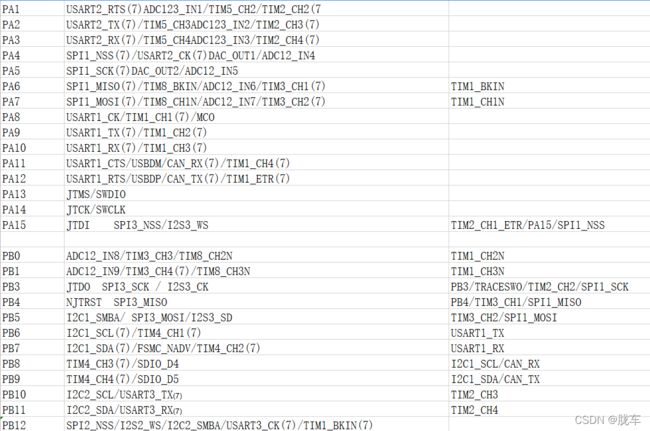STM32F1—呼吸灯—端口复用,重映射,GPIO,TIM,PWM
目录
一.前言
二.主要知识点
1.端口复用
2.重映射
3.LED灯
(1)led.h
(2)led.c
4.定时器
(1)tim.h
(2)tim.c
5.PWM
(2)pwm.h
(2)pwm.c
6.主函数
main.c
7.部分函数补充
(1)TIM_SetCompare
三.感想
一.前言
本人所用的是STM32F103VET6。
写此文是为作为学习笔记,如有不足还请多指教。
二.主要知识点
1.端口复用
GPIO作为内置外设使用时就叫复用,也叫默认复用功能,不把GPIO口当作单纯的I/O口而是赋予它一个外设的含义。
表1:端口复用和重映射
(第一列:引脚;第二列:默认复用功能;第三列:重映射)
此时需要使能GPIO时钟,同时使能内置外设时钟
RCC_APB2PeriphClockCmd(RCC_APB2Periph_GPIOB, ENABLE); //使能 GPIO时钟
RCC_APB1PeriphClockCmd(RCC_APB1Periph_TIM3, ENABLE); //使能 外设时钟2.重映射
重映射是将某些I/O口上面的功能映射到其他I/O口上面去。
表2:同上
(第一列:引脚;第二列:默认复用功能;第三列:重映射)
同上一样需要使能GPIO时钟,同时使能内置外设时钟,但要注意还需要再使能AFIO时钟
RCC_APB2PeriphClockCmd(RCC_APB2Periph_GPIOB, ENABLE); //使能 GPIO时钟
RCC_APB1PeriphClockCmd(RCC_APB1Periph_TIM3, ENABLE); //使能 外设时钟
RCC_APB2PeriphClockCmd(RCC_APB2Periph_AFIO, ENABLE); //使能 AFIO时钟
GPIO_PinRemapConfig(GPIO_PartialRemap_TIM3, ENABLE); //部分重映射Timer3 TIM3_CH2->PB53.LED灯
(1)led.h
#ifndef __LED_H
#define __LED_H
#include "stm32f10x.h"
#define LED_R_Pin GPIO_Pin_5
#define LED_G_Pin GPIO_Pin_0
#define LED_B_Pin GPIO_Pin_1
#define LED_Port GPIOB
void Led_R_Config(void);
void Led_B_Config(void);
void Led_G_Config(void);
void Led_Config(void);
#endif /* __LED_H */
(2)led.c
#include "led.h"
void Led_R_Config(void)
{
static GPIO_InitTypeDef GPIO_InitStructure;
//配置GPIO引脚为复用功能
GPIO_InitStructure.GPIO_Pin=LED_R_Pin;
GPIO_InitStructure.GPIO_Mode=GPIO_Mode_AF_PP;//选择引脚为复用推挽功能
GPIO_InitStructure.GPIO_Speed=GPIO_Speed_50MHz;//选择引脚速度
GPIO_Init(LED_Port,&GPIO_InitStructure); //初始化GPIO
RCC_APB2PeriphClockCmd(RCC_APB2Periph_GPIOB, ENABLE);
}
void Led_G_Config(void)
{
static GPIO_InitTypeDef GPIO_InitStructure;
GPIO_InitStructure.GPIO_Pin=LED_G_Pin;
GPIO_InitStructure.GPIO_Mode=GPIO_Mode_AF_PP;
GPIO_InitStructure.GPIO_Speed=GPIO_Speed_50MHz;
GPIO_Init(LED_Port,&GPIO_InitStructure);
RCC_APB2PeriphClockCmd(RCC_APB2Periph_GPIOB, ENABLE);
}
void Led_B_Config(void)
{
static GPIO_InitTypeDef GPIO_InitStructure;
GPIO_InitStructure.GPIO_Pin=LED_B_Pin;
GPIO_InitStructure.GPIO_Mode=GPIO_Mode_AF_PP;
GPIO_InitStructure.GPIO_Speed=GPIO_Speed_50MHz;
GPIO_Init(LED_Port,&GPIO_InitStructure);
RCC_APB2PeriphClockCmd(RCC_APB2Periph_GPIOB, ENABLE);
}
void Led_Config(void)
{
static GPIO_InitTypeDef GPIO_InitStructure;
GPIO_InitStructure.GPIO_Pin=LED_R_Pin | LED_G_Pin | LED_B_Pin;
GPIO_InitStructure.GPIO_Mode=GPIO_Mode_AF_PP;
GPIO_InitStructure.GPIO_Speed=GPIO_Speed_50MHz;
GPIO_Init(LED_Port,&GPIO_InitStructure);
RCC_APB2PeriphClockCmd(RCC_APB2Periph_GPIOB, ENABLE);
}
4.定时器
(1)tim.h
#ifndef __TIM_H
#define __TIM_H
#include "stm32f10x.h"
void TIM3_Config(void);
#endif /* __TIM_H */
(2)tim.c
#include "tim.h"
//定时器3配置
void TIM3_Config(void)
{
static TIM_TimeBaseInitTypeDef TIM_TimeBaseStructure;
//使能GPIO时钟、定时器3时钟和AFIO时钟,并部分重映射
RCC_APB2PeriphClockCmd(RCC_APB2Periph_GPIOB, ENABLE); //使能 GPIO时钟
RCC_APB1PeriphClockCmd(RCC_APB1Periph_TIM3, ENABLE); //使能 外设时钟
RCC_APB2PeriphClockCmd(RCC_APB2Periph_AFIO, ENABLE); //使能 AFIO时钟
GPIO_PinRemapConfig(GPIO_PartialRemap_TIM3, ENABLE); //部分重映射 TIM3_CH2->PB5
//配置定时器3
TIM_TimeBaseStructure.TIM_Prescaler=0; //预分频器
TIM_TimeBaseStructure.TIM_CounterMode=TIM_CounterMode_Up; //计数模式
TIM_TimeBaseStructure.TIM_Period=99; //定时器周期
//TIM_TimeBaseStructure.TIM_ClockDivision=; //时钟分频
//TIM_TimeBaseStructure.TIM_RepetitionCounter=; //重复计算器
TIM_TimeBaseInit(TIM3,&TIM_TimeBaseStructure); //初始化定时器
//计数器计数一次的时间:1 / [APB1Periph / (Prescaler + 1)]
//中断一次的时间:[(Prescaler + 1) / APB1Periph] * Period
//开启定时器3
TIM_Cmd(TIM3,ENABLE);
}
5.PWM
(2)pwm.h
#ifndef __PWM_H
#define __PWM_H
#include "stm32f10x.h"
void PWM_TIM3CH2_Config(void);
#endif /* __PWM_H */
(2)pwm.c
#include "pwm.h"
void PWM_TIM3CH2_Config(void)
{
static TIM_OCInitTypeDef TIM_OCInitStructure;
//配置定时器3的通道2占空比
TIM_OCInitStructure.TIM_OCMode=TIM_OCMode_PWM2;
TIM_OCInitStructure.TIM_OutputState=TIM_OutputState_Enable; //打开或者关闭脉冲输出
TIM_OCInitStructure.TIM_Pulse = 50; //比较值
TIM_OCInitStructure.TIM_OCPolarity=TIM_OCPolarity_High; //有效电平设置为高状态
TIM_OC2Init(TIM3,&TIM_OCInitStructure); //初始化定时器通道2
}
6.主函数
main.c
#include "stm32f10x.h"
#include "pwm.h"
#include "delay.h"
#include "led.h"
#include "tim.h"
int main(void)
{
int32_t i=0; //为了使定时器比较值发生变化使用,这样可以实现动态PWM波
//调用定时器3的配置函数
Led_R_Config();
TIM3_Config();
PWM_TIM3CH2_Config();
//主函数循环
while(1)
{
//灯渐灭
for(i=100;i>=0;i--)
{
TIM_SetCompare2(TIM3,i);//2通道,定时器3,占空比为i/100
delay_ms(1);
}
//灯渐亮
for(i=0;i<=100;i++)
{
TIM_SetCompare2(TIM3,i);
delay_ms(1);
}
}
}
7.部分函数补充
(1)TIM_SetCompare
这个函数有四个,分别是TIM_SetCompare1,TIM_SetCompare2,TIM_SetCompare3,TIM_SetCompare4。
第一个参数传入相应定时器,第二个参数是输出PWM的高电平的时间。这个值如果大于等于周期的值,将会与周期保持一致。
三.感想
上述内容拼拼凑凑,都是从CSDN大佬那里习得的,非常感谢大佬们的文章。
以此记录我的点滴学习。

